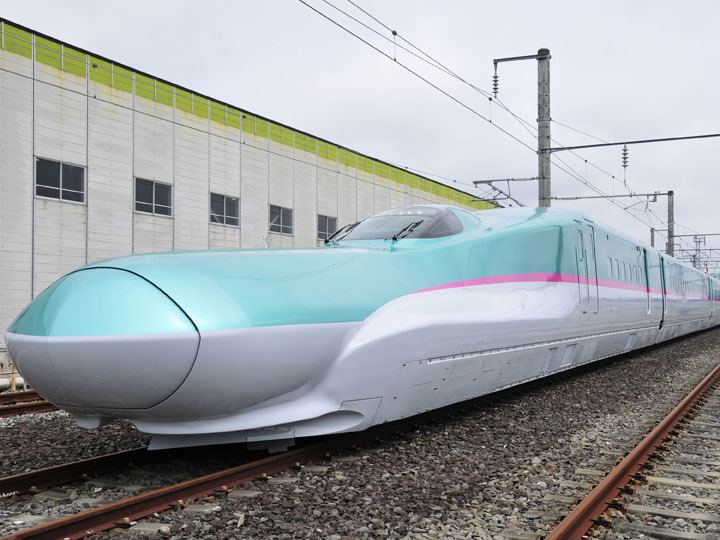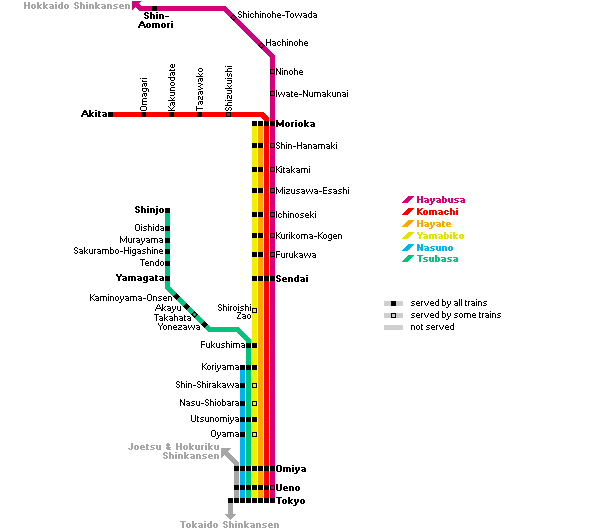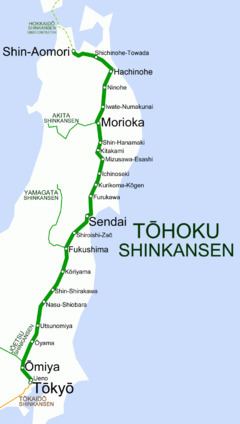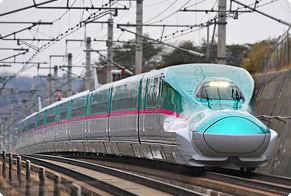Native name 東北新幹線 Status Operational Locale Japan | Opened 23 June 1982 Stations 23 | |
 | ||
Terminis Shin-Aomori Station, Tokyo Station | ||
T hoku shinkansen hayabusa
The Tohoku Shinkansen (東北新幹線) is a Japanese high-speed Shinkansen rail line, connecting Tokyo with Aomori in Aomori Prefecture in a route length of 674 km (419 miles), making it Japan's longest Shinkansen line. It runs through the more sparsely populated Tōhoku region of Japan's main island, Honshu, and is being extended as the Hokkaido Shinkansen through the Seikan Tunnel to Shin-Hakodate-Hokuto (this section opened March 2016) and on to Sapporo by 2030. It has two Mini-shinkansen branch lines, the Yamagata Shinkansen and Akita Shinkansen. The line is operated by East Japan Railway Company (JR East).
Contents
- T hoku shinkansen hayabusa
- Services
- Rolling stock
- Types no longer used
- Non revenue earning types
- History
- Tohoku earthquake and tsunami
- 25th anniversary
- 30th anniversary
- References
Services
There are four services in operation:
One service has been discontinued:
Through trains on the Akita Shinkansen and Yamagata Shinkansen lines also run on Tōhoku Shinkansen tracks from Morioka and Fukushima respectively.

As of 16 March 2013, the maximum line speed is 110 km/h (70 mph) between Tokyo and Ōmiya, 275 km/h (170 mph) between Ōmiya and Utsunomiya, 320 km/h (200 mph) between Utsunomiya and Morioka, and 260 km/h (160 mph) between Morioka and Shin-Aomori. On 30 October 2012, JR East announced that it is pursuing research and development to increase speeds to 360 km/h (224 mph) on the Tohoku Shinkansen by 2020.
Rolling stock
As of March 2015, the following types are used on Tohoku Shinkansen services.

Types no longer used

Non-revenue-earning types
History
From Shin-Aomori, construction is underway to continue the line to Shin-Hakodate in Hokkaido (148.9 km, due to open by March 2016 under the name Hokkaido Shinkansen), passing through the world's longest undersea railway tunnel, the Seikan Tunnel, and a further 211.3 km to Sapporo by 2030.
The mountainous terrain that the line passes through has necessitated heavy reliance on tunnels. The Iwate-Ichinohe Tunnel on the Morioka-Hachinohe stretch, completed in 2000, was briefly the world's longest land rail tunnel at 25.8 km, but in 2005 it was superseded by the Hakkōda Tunnel on the extension to Aomori, at 26.5 km. In 2007 the Lötschberg Base Tunnel (34.57 km), and in 2010 the Gotthard Base Tunnel (57 km, bored through and due in service by 2016) in Switzerland superseded both.
Tohoku earthquake and tsunami
On the afternoon of 11 March 2011, services on the Tohoku Shinkansen were suspended as a result of the Tōhoku earthquake and tsunami. JR East estimated that around 1,100 repairs would be required for the line between Omiya and Iwate-Numakunai, ranging from collapsed station roofs to bent power pylons.
Limited service on the line was restored in segments: Tokyo to Nasu-Shiobara was re-opened on 15 March, and Morioka to Shin-Aomori was re-opened on 22 March. The line between Morioka and Ichinoseki re-opened on 7 April, Nasu-Shiobara and Fukushima on 12 April, and the rest of the line on or around 30 April, although not at full speed or a full schedule. The trains returned to full-speed operations on 23 September 2011.
25th anniversary
On 23 June 2007, 10-car set K47 was used for a special Yamabiko 931 service from Omiya to Morioka to mark the 25th anniversary of the opening of the Tohoku Shinkansen.
30th anniversary
On 23 June 2012, 10-car set K47 was used for a special Yamabiko 235 service from Omiya to Morioka to mark the 30th anniversary of the opening of the Tohoku Shinkansen.
